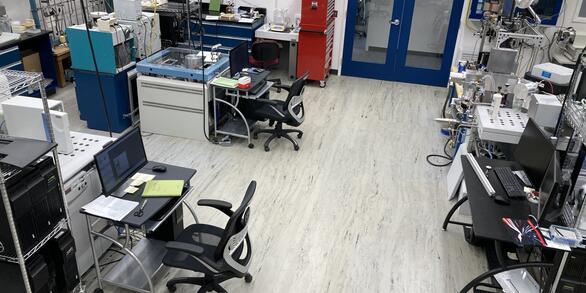Craig A Stricker, PhD
Craig Stricker is an ecologist at the Fort Collins Science Center that specializes in the application of chemical and isotopic tracers for addressing societally relevant questions related to ecosystem ecology. His research interests are focused on biogeochemistry, food webs, and animal resource allocation and movement.
Geology, Geophysics, and Geochemistry Stable Isotope Laboratory (GSIL)

The GSIL is a state-of-the-art facility located on the Denver Federal Center that specializes in the measurement of light stable isotope — Hydrogen (H), Carbon (C), Nitrogen (N), Oxygen (O), and Sulfur (S) — compositions and other chemical and biomarker analytes in matrices relevant to the Earth sciences.
Research Highlights
- Continental-scale nutrient and contaminant delivery by Pacific salmon
- Diet and macronutrient assimilation in an Arctic predator
- Animal tracing with sulfur isotopes
- Effects of protein overconsumption limit dietary adaptation in an apex predator
- Carbon chemistry of peatlands in the southeastern USA
- Design, development, and implementation of IsoBank
- Diet energy density associated with survival, habitat, and population dynamics
As an ecologist at the Fort Collins Science Center, Craig Stricker’s research program focuses on an improved understanding of the roles of hydrology, biogeochemistry, and food web interactions on ecosystem structure and function with the goal of assisting land managers. His expertise in chemical and isotopic tracers offers novel insights in ecosystem ecology and has benefitted multidisciplinary collaborations across a variety of state, federal, and academic institutions. Tracer-based approaches to studying wildlife and ecosystems is a capability unique to Stricker’s research and the Fort Collins Science Center with examples ranging from wildlife nutrition, trophic dynamics, impacts of invasive species, animal movements and phenology, biogeochemistry, and environmental stressors such as fire and drought. The spatial domain of his work ranges from discrete habitats, regional assessments, to continental and oceanic basins, with studies from the sub-tropics to the high Arctic. Results of these projects inform on species life history and fitness to ecosystem health and function, but also offer frameworks for monitoring programs, model development, restoration, and risk assessment.
Professional Experience
2009 - Present, Research Biologist, US Geological Survey, Fort Collins Science Center
2005 - 2008, Research Biologist, US Geological Survey, Geologic Division - Crustal, Geology, and Geochemistry
2002 - 2004, Mendenhall Postdoctoral Fellow, US Geological Survey, Geologic Division - Crustal, Geology, and Geochemistry
Education and Certifications
PhD in Limnology, Michigan State University, 2003
MS in Aquatic Ecology, Central Michigan University, 1997
BS in Biology, Central Michigan University, 1994
Science and Products
Foraging segregation and genetic divergence between geographically proximate colonies of a highly mobile seabird
Evidence of cryptic individual specialization in an opportunistic insectivorous bat
Delayed age at weaning in Southeast Alaska Steller sea lions determined using stable isotopes of carbon and nitrogen
Foraging ecology of bottlenose dolphins: a stable isotopic reconstruction over six decades
Mercury bioaccumulation and biomagnification in Ozark stream ecosystems
Biologically-mediated flux of trace metals from streams to riparian spiders: a large scale survey in mineralized alpine ecosystems
Distribution of total mercury (THg) in California sea lions (Zalophus californianus) and their parasitic fauna
Using stable isotopes to understand hydrochemical processes in and around a Prairie Pothole wetland in the Northern Great Plains, USA
The role of critical zone processes in the evolution of the Prairie Pothole Region wetlands
Transfer of trace metals from streams to terrestrial food webs by emerging aquatic insects in mineralized alpine ecosystems
Effects of climate change on nutrition and genetics of White-tailed Ptarmigan
Benthic macroinvertebrate and fish communities in Lake Huron are linked to submerged groundwater vents
Non-USGS Publications**
**Disclaimer: The views expressed in Non-USGS publications are those of the author and do not represent the views of the USGS, Department of the Interior, or the U.S. Government.
Science and Products
Foraging segregation and genetic divergence between geographically proximate colonies of a highly mobile seabird
Evidence of cryptic individual specialization in an opportunistic insectivorous bat
Delayed age at weaning in Southeast Alaska Steller sea lions determined using stable isotopes of carbon and nitrogen
Foraging ecology of bottlenose dolphins: a stable isotopic reconstruction over six decades
Mercury bioaccumulation and biomagnification in Ozark stream ecosystems
Biologically-mediated flux of trace metals from streams to riparian spiders: a large scale survey in mineralized alpine ecosystems
Distribution of total mercury (THg) in California sea lions (Zalophus californianus) and their parasitic fauna
Using stable isotopes to understand hydrochemical processes in and around a Prairie Pothole wetland in the Northern Great Plains, USA
The role of critical zone processes in the evolution of the Prairie Pothole Region wetlands
Transfer of trace metals from streams to terrestrial food webs by emerging aquatic insects in mineralized alpine ecosystems
Effects of climate change on nutrition and genetics of White-tailed Ptarmigan
Benthic macroinvertebrate and fish communities in Lake Huron are linked to submerged groundwater vents
Non-USGS Publications**
**Disclaimer: The views expressed in Non-USGS publications are those of the author and do not represent the views of the USGS, Department of the Interior, or the U.S. Government.

